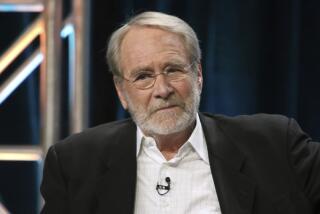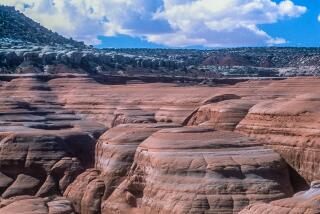Readers React: Speak ill of John Muir? Brace for a backlash
Readers of The Times’ print newspaper may recall the handful of letters published Saturday defending John Muir after an earlier article had quoted academics and environmentalists questioning the sainted conservationist’s continued relevance. Published alongside those letters was a blurb noting that all 36 of the letters received on the topic up until Friday rose to Muir’s defense.
Nearly all of the readers took issue specifically with comments by Jon Christensen, a historian at UCLA’s Institute of Environment and Sustainability, who was quoted as saying, among other things, that “Muir’s legacy has to go” and that “it’s just not useful anymore.”
Since Saturday, more than two dozen additional letters have trickled in. The updated score?
Readers supporting Muir’s continued sainthood: 56. Readers siding with Christensen and other Muir skeptics: 0.
Summing up the reaction as at odds with Christensen would be an understatement. The letters ranged from polite disagreement to taking offense at the suggestion that Muir’s work deserves renewed scrutiny. Several readers took umbrage with the article’s passing mention of Muir’s involvement in uprooting California Indians from their land, saying that’s equivalent to diminishing Thomas Jefferson’s or George Washington’s work as founding fathers because of their status as slave owners.
As a native, lifelong Californian deeply in awe of the harsh contrasts and fragility that characterize this state’s singularly resplendent geography, I can’t say I’m surprised by this reaction -- although I do understand Christensen’s point, however crudely he made it. Not everyone in our increasingly urban, diverse and water-starved state can afford a cathartic trip through the Sierra wilderness and gain a sense of how dependent our city-dwelling lives are on the fickle relationship between geography and climate. Urban parks, even the small oases that interrupt the concrete and asphalt expanses along the L.A. River, provide exponentially more accessible contacts with nature than far-off unspoiled deserts and mountains.
Still, calling the legacy of Muir -- the man who roused Californians’ collective environmental conscience -- “not useful anymore” stings a little too hard, and Christensen has admirably clarified his comments. His post at L.A. Observed is definitely worth a read.
Meanwhile, here are more letters from readers.
Sherida Bush of Martinez, Calif. -- who sits on the John Muir Assn. board of directors but says she speaks only for herself -- embraces Muir’s legacy, warts and all:
Muir’s legacy is alive and his message is as powerful as ever. To say he is irrelevant because environmental issues have changed is to say the views of, say, Lincoln, Ghandi and Martin Luther King Jr. are irrelevant because the world has “moved on.” Just as the views of great leaders will always be relevant, the true message of Muir is fundamental to conservation.
Muir is an icon, but he should never have been placed on a pedestal; he was a human being who -- surprise -- wasn’t perfect. Nevertheless, many of the criticisms in the article are gross distortions that brevity does not allow me to address.
Muir stated his life goal as, “I care to live only to entice people to look at nature’s loveliness,” but he knew in doing so he would also engender in them a desire to protect nature’s gifts. People want to protect only what they know and care about. In his lifetime, Muir saw nature not only despoiled, he witnessed its disappearance. He realized that with his writing, he could help turn that around.
Such is Muir’s profound role -- to inspire others to not only appreciate but also become an advocate for nature. Our beautiful natural lands -- and the creatures, plants, forests and natural resources they support -- will always need advocates. Muir knew that, and we are fortunate that his ideas have resonated with people throughout the centuries or most of the natural lands we enjoy today would be long gone.
Torrance resident Maggie Coble says we owe a lot to Muir:
I found this article very disturbing. Environmentalists today stand on Muir’s shoulders, whether they acknowledge it or not. Without his passion, eloquence, intelligence and hard work, we would not have the privilege of living in a state and country where we can view majestic Sequoia trees, grand canyons and Yosemite’s jewels.
Muir’s Sierra Club has been on the forefront of the battles to protect the wilderness for us and future generations. The arrogance of UCLA historian Christensen to claim that it’s time to bury Muir’s legacy and move on is akin to dismissing Thomas Jefferson as a major founding father of the United States.
Glenn Pascall of Dana Point, the librarian and finance chair for the Sierra Club Angeles Chapter, responds to charges made against his organization:
Muir’s Sierra Club is charged with being elitist, detached from ascendant minority groups, indifferent to urban recreational needs and uninterested in providing mountain areas with trails. These inferences are so off the mark they require refutation.
Our active involvement in the San Gabriel Mountains as a national monument was above all to support the San Gabriel River as an urban recreation resource for low-income and disadvantaged neighborhoods. Our recent selection of outstanding professional Angelica Gonzalez as conservation coordinator supports the goal of intensive outreach to Hispanic and other urban communities.
Christiansen’s dismissive and condemnatory attitude toward Muir should not go unchallenged, nor was Muir merely a “good guy” who did things a long time ago. Muir remains deeply relevant to the present and to our region.
To illustrate, see the 82 Muir quotes and photos of the Southern California outdoors in daily installments on the Angeles Chapter’s Facebook site. Muir said these things about the Sierra Nevada yet they perfectly fit our local mountains. Thirty-five of the photos are from roadside locations accessible to all, and the rest are from trails on public lands.
Muir died in L.A. 100 years ago this Christmas Eve. His spirit and legacy continue to kindle a spark of wonder and gratitude in experiencing the great outdoors. Muir walks on, into the 21st century, wherever people encounter and celebrate nature -- whether in wilderness or the city.
Santa Barbara resident Lesley J. Briggin-Masuda says Muir was more than just an inspiring writer:
While it is true that the gifted Muir could indeed wax eloquent when writing about his beloved trees, mountains and waterfalls, they were not merely “writings of mystical enlightenment.”
Muir was not only a conservationist but a brilliant inventor and gifted scientist -- explaining the process of glaciation to the geologists of his day and providing mapping and the botanical identification of countless plants. In later years he proved to be a gifted agriculturist at his ranch in Martinez, Calif., where he did all the cultivating of the orchards himself.
Muir would be the first to agree that “nature” can be found in any number of settings. Read his account of his explorations in other parts of the U.S. and world, including remote Alaska (which was not yet a state).
Rather than outdated, Muir is even more relevant today. His enduring legacy of wilderness conservation and appreciation for the natural world has enriched the lives of countless generations of Americans of all ethnicities, and it will continue to do so far into the future.
John Saville of Corona says Muir’s appeal crosses demographic lines:
One can argue the merits, but for Christensen to say that Muir’s or anyone’s legacy “has to go,” is “just not useful” or is a “dead end” sounds like deliberate provocation.
Is there nothing Muir said or did that contributes to today’s new environmental debates or nourishes the universal hunger to seek peace, wherever it is found?
In a world where there others’ viewpoints are so often dismissed as irrelevant, Muir still reminds us that some things are not bound to any time or demographic: “Everybody needs beauty as well as bread, places to play in and pray in, where nature may heal and give strength to body and soul.”
Follow the Opinion section on Twitter @latimesopinion
More to Read
A cure for the common opinion
Get thought-provoking perspectives with our weekly newsletter.
You may occasionally receive promotional content from the Los Angeles Times.











